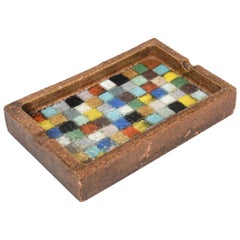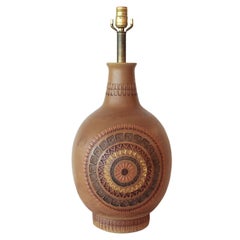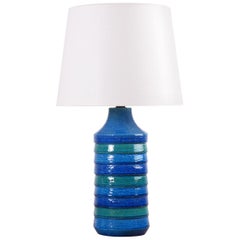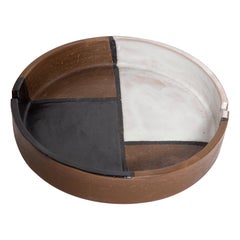Bitossi Furniture
Like a Fellini movie, the ceramics of the famed Italian company Bitossi Ceramiche embody a creative spectrum that ranges from the playful and earthy to the high-minded and provocative. Based in Florence, Bitossi draws on craft traditions that date back to the 1500s. These find expression in Bitossi pottery that includes artisanal vintage vases and animal figures by the firm’s longtime art director Aldo Londi, as well as the colorful, totemic vessels designed by the high priest of postmodernism, Ettore Sottsass.
Bitossi was incorporated by Guido Bitossi in 1921, though the family began making art pottery in the mid-19th century. In the 1930s, Londi came aboard, bringing with him a mindset that respected time-honored craft, yet looked also to the future. On the one hand, Londi’s perspective fostered the making of Bitossi’s popular whimsical cats, owls, horses and other animal figures, hand-shaped and -carved and finished in a rich azure glaze known as “Rimini Blue.”
But with his other hand, Londi reached out to thoughtful, experimental designers such as Sottsass. After hiring Sottsass to design ceramics for his New York imports company, Raymor, American entrepreneur Irving Richards connected the Milanese design polymath to Londi, who introduced Sottsass to ceramics in the 1950s.
During that decade, some 20 years before he founded the Memphis postmodern design collective in Milan, Sottsass used the Bitossi kilns to create timeless works that manifest both primitive forms and modern geometries. In later decades, Bitossi would welcome new generations of designers, which have included such names as Ginevra Bocini and Karim Rashid.
While always looking forward, Bitossi is firm in their belief that mastery of craft is the first step towards beautiful design. As you will see from the works offered on these pages, that is a winning philosophy.
Find a collection of vintage Bitossi decorative objects, lighting and serveware on 1stDibs.
1960s Italian Mid-Century Modern Vintage Bitossi Furniture
Ceramic, Art Glass
1960s Italian Mid-Century Modern Vintage Bitossi Furniture
Ceramic
1960s Italian Mid-Century Modern Vintage Bitossi Furniture
Ceramic, Pottery
1960s Italian Mid-Century Modern Vintage Bitossi Furniture
Ceramic, Fabric
20th Century Italian Mid-Century Modern Bitossi Furniture
Pottery
1960s Italian Vintage Bitossi Furniture
Ceramic
Mid-20th Century Italian Mid-Century Modern Bitossi Furniture
Stoneware
Mid-20th Century Italian Mid-Century Modern Bitossi Furniture
Ceramic
Mid-20th Century Italian Mid-Century Modern Bitossi Furniture
Pottery, Terracotta, Ceramic
1960s Italian Mid-Century Modern Vintage Bitossi Furniture
Ceramic
Mid-20th Century Italian Mid-Century Modern Bitossi Furniture
Ceramic
1960s Italian Mid-Century Modern Vintage Bitossi Furniture
Ceramic
1960s Italian Mid-Century Modern Vintage Bitossi Furniture
Pottery, Ceramic
Mid-20th Century Italian Mid-Century Modern Bitossi Furniture
Ceramic
1960s Italian Mid-Century Modern Vintage Bitossi Furniture
Ceramic
1960s Italian Mid-Century Modern Vintage Bitossi Furniture
Metal
1950s Italian Mid-Century Modern Vintage Bitossi Furniture
Ceramic
1960s Italian Mid-Century Modern Vintage Bitossi Furniture
Ceramic
1960s Italian Vintage Bitossi Furniture
Bitossi furniture for sale on 1stDibs.
Creators Similar to Bitossi
- What is Bitossi's style?1 Answer1stDibs ExpertApril 5, 2024Bitossi's style has changed over the course of its more than 100-year history. However, the brand is most famous for its mid-century modern pieces made during the 1950s and ’60s. Bitossi ceramics also reflect the hallmarks of Scandinavian modern style. Explore a wide range of Bitossi pottery from some of the world's top sellers on 1stDibs.
- Is all Bitossi signed?1 Answer1stDibs ExpertApril 5, 2022No, not all Bitossi is signed. A small number bear no marks at all. Most have either a hand-applied signature or a stamp that says "Italy" or "Made in Italy." You'll find a collection of expertly vetted Bitossi decorative objects and lighting on 1stDibs.
- Is Flavia the same as Bitossi?1 Answer1stDibs ExpertFebruary 1, 2024No, Flavia and Bitossi are not exactly the same. The company Gruppo Colorobbia produces both Flavia and Bitossi pottery. Beginning in 1976, the Flavia collection featured more decorative art pieces than the Bitossi line. In 1994, Gruppo Colorobbia began calling everything Bitossi. However, you can find some select pottery that bears both the Flavia and Bitossi names. Explore a wide range of Bitossi pieces on 1stDibs.
- How do you identify a Bitossi?1 Answer1stDibs ExpertFebruary 13, 2024To identify a Bitossi, look for the maker's markings on the bottom and other inconspicuous areas. Beginning in the 1950s, Bitossi typically marked its pottery with a handwritten style number and the words "Made in Italy" or "Italy." After the 1970s, the Italian company started to imprint its name on its pieces. However, some Bitossi pottery is unmarked. As a result, you may want to consult a certified appraiser or a knowledgeable dealer for assistance with identification. On 1stDibs, explore a diverse assortment of Bitossi pottery.
- 1stDibs ExpertFebruary 1, 2024The history of Bitossi pottery began in 1926, when Guido Bitossi founded his shop in Montelupo Fiorentino, near Florence, Italy. He descended from a long line of artisans, including painters, sculptors and potters. His son Londi became the creative director of Bitossi in 1946 and was responsible for introducing the colorful glazes that Bitossi has become famous for during his 50-year tenure. During the 1950s, Ettore Sottsass began to design unique pieces for Bitossi, and his geometric bowls and vases redefined the art form of pottery and set major trends during the mid-century period. After Londi Bitossi stepped down, a new generation of the family took over, with Guido's granddaughter Cinzia Bitossi serving as artistic director and his great-granddaughter Ginevra Bocin acting as CEO. On 1stDibs, shop a selection of Bitossi pottery.





